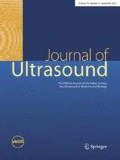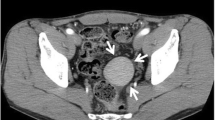Abstract
Introduction
Accessory spleen, also known as supernumerary spleen or splenunculum, is a congenital anomaly of the spleen due to a fusion defect during the embryogenesis. Usually it is detected casually during an ultrasound (US) examination of the abdomen and it is asymptomatic.
Case report: results
We present a case of a 12 years old male patient, with 2-days history of left abdominal pain, without fever, gastrointestinal or genitourinary symptoms. The day before our observation, the patient had gone to another hospital, from where he had been discharged with medical analgesic therapy, without any benefit. Blood tests were normal, the Ultrasound abdominal examination showed normal aspect of abdominal organs, but the presence in the left side of a small round parenchymal structure surrounded by hyperechogenic mesenteric fat. We interpreted this image as an accessory spleen, complicated by torsion. As the torsion of accessory spleen is a quite rare occurrence, we carried out a contrast enhanced ultrasound (CEUS) to get more information. CEUS showed the absence of enhancement of the nodular formation, suggestive for a complete lack of vascularization; the spleen was normally enhanced. While the management in case of accessory spleen torsion is non-operative, in this case the patient underwent surgical exploration, due to the persistence of abdominal pain despite the medical therapy, with clinical signs of peritoneal reaction, mimicking an acute abdomen. Surgery confirmed the diagnosis of accessory spleen torsion.
Discussion and conclusions
In conclusion, US is the first diagnostic tool in pediatric abdominal pain and allows to direct the diagnosis; the use of CEUS helps to clarify the US reports, without leaving doubts about the parenchymal vascularization of the abdominal organ involved.



Similar content being viewed by others
References
Di Serafino M, Verde F, Ferro F et al (2018) Ultrasonography of the pediatric spleen: a pictorial essay. J Ultrasound. https://doi.org/10.1007/s40477-018-0341-2
Landmann A, Johnson JJ, Webb KM et al (2016) Accessory spleen presenting as acute abdomen: a case report and operative management. J Pediatr Surg Case Rep 12:9–10. https://doi.org/10.1016/j.epsc.2016.05.011
Ishibashi H, Oshio T, Sogami T et al (2012) Torsion of an accessory spleen with situs inversus in a child. J Med Investig 59:220–223
Gayer G, Hertz M, Strauss S et al (2006) Congenital anomalies of the spleen. Semin Ultrasound CT MR 27:358–369. https://doi.org/10.1053/j.sult.2006.06.002
Paterson A, Frush DP, Donnelly LF et al (1999) A pattern-oriented approach to splenic imaging in infants and children. Radiographics 19:1465–1485. https://doi.org/10.1148/radiographics.19.6.g99no231465
Babcock TL, Coker DD, Haynes JL et al (1974) Infarction of an accessory spleen causing an acute abdomen. Am J Surg 127:336–337
Back SJ, Maya CL, Khwaja A (2017) Ultrasound of congenital and inherited disorders of the pediatric hepatobiliary system, pancreas and spleen. Pediatr Radiol 47:1069–1078. https://doi.org/10.1007/s00247-017-3869-y
Ozeki M, Asakuma M, Go N et al (2015) Torsion of an accessory spleen: a rare case preoperatively diagnosed and cured by single-port surgery. Surg Case Rep 1:100. https://doi.org/10.1186/s40792-015-0101-x
Bard V, Goldberg N, Kashtan H (2014) Torsion of a huge accessory spleen in a 20-year-old patient. Int J Surg Case Rep 5:67–69
Di Giacomo V, Trinci M, Van der Byl G (2015) Ultrasound in newborns and children suffering from non-traumatic acute abdominal pain: imaging with clinical and surgical correlation. J Ultrasound 18:385–393. https://doi.org/10.1007/s40477-014-0087-4
Dietrich CF, Averkiou M, Nielsen MB et al (2018) How to perform contrast-enhanced ultrasound (CEUS). Ultrasound Int Open 4:E2–E15. https://doi.org/10.1055/s-0043-123931
Schreiber-Dietrich DG, Cui XW, Piscaglia F et al (2014) Contrast enhanced ultrasound in pediatric patients: a real challenge. Z Gastroenterol 52:1178–1184. https://doi.org/10.1055/s-0034-1366766
Chiorean L, Cui XW, Tannapfel A et al (2015) Benign liver tumors in pediatric patients—review with emphasis on imaging features. World J Gastroenterol 21:8541–8561. https://doi.org/10.3748/wjg.v21.i28.8541
Riccabona M (2012) Application of a second-generation US contrast agent in infants and children—a European questionnaire-based survey. Pediatr Radiol 42:1471–1480. https://doi.org/10.1007/s00247-012-2472-5
Menichini G, Sessa B, Trinci M et al (2015) Accuracy of contrast-enhanced ultrasound (CEUS) in the identification and characterization of traumatic solid organ lesions in children: a retrospective comparison with baseline US and CE-MDCT. Radiol Med 120:989–1001. https://doi.org/10.1007/s11547-015-0535-z
Miele V, Piccolo CL, Trinci M et al (2016) Diagnostic imaging of blunt abdominal trauma in pediatric patients. Radiol Med 121:409–430. https://doi.org/10.1007/s11547-016-0637-2
Rafaelsen SR, Jakobsen A (2011) Contrast-enhanced ultrasound vs multidetector computed tomography for detecting liver metastases in colorectal cancer: a prospective, blinded, patient-by-patient analysis. Colorectal Dis 13:420–425. https://doi.org/10.1111/j.1463-1318.2010.02288.x
Bernatik T, Schuler A, Kunze G et al (2015) Benefit of Contrast-Enhanced Ultrasound (CEUS) in the follow-up care of patients with colon cancer: a prospective multicenter study. Ultraschall Med 36:590–593. https://doi.org/10.1055/s-0041-107833
Miele V, Piccolo CL, Sessa B et al (2016) Comparison between MRI and CEUS in the follow-up of patients with blunt abdominal trauma managed conservatively. Radiol Med 121:27–37. https://doi.org/10.1007/s11547-015-0578-1
Piccolo CL, Trinci M, Pinto A et al (2018) Role of contrast-enhanced ultrasound (CEUS) in the diagnosis and management of traumatic splenic injuries. J Ultrasound 21:315–327. https://doi.org/10.1007/s40477-018-0327-0
Dietrich CF, Kratzer W, Strobe D et al (2006) Assessment of metastatic liver disease in patients with primary extrahepatic tumors by contrast-enhanced sonography versus CT and MRI. World J Gastroenterol 12:1699–1705. https://doi.org/10.3748/wjg.v12.i11.1699
Author information
Authors and Affiliations
Corresponding author
Ethics declarations
Conflict of interest
The authors declare no potential conflicts of interests associated with this study.
Ethical approval
All procedures performed in studies involving human participants were in accordance with the ethical standards of the institutional and/or national research committee and with the 1964 Helsinki declaration and its later amendments or comparable ethical standards.
Informed consent
Informed consent was obtained from all individual participants included in the study.
Additional information
Publisher's Note
Springer Nature remains neutral with regard to jurisdictional claims in published maps and institutional affiliations.
Rights and permissions
About this article
Cite this article
Trinci, M., Ianniello, S., Galluzzo, M. et al. A rare case of accessory spleen torsion in a child diagnosed by ultrasound (US) and contrast-enhanced ultrasound (CEUS). J Ultrasound 22, 99–102 (2019). https://doi.org/10.1007/s40477-019-00359-4
Received:
Accepted:
Published:
Issue Date:
DOI: https://doi.org/10.1007/s40477-019-00359-4




